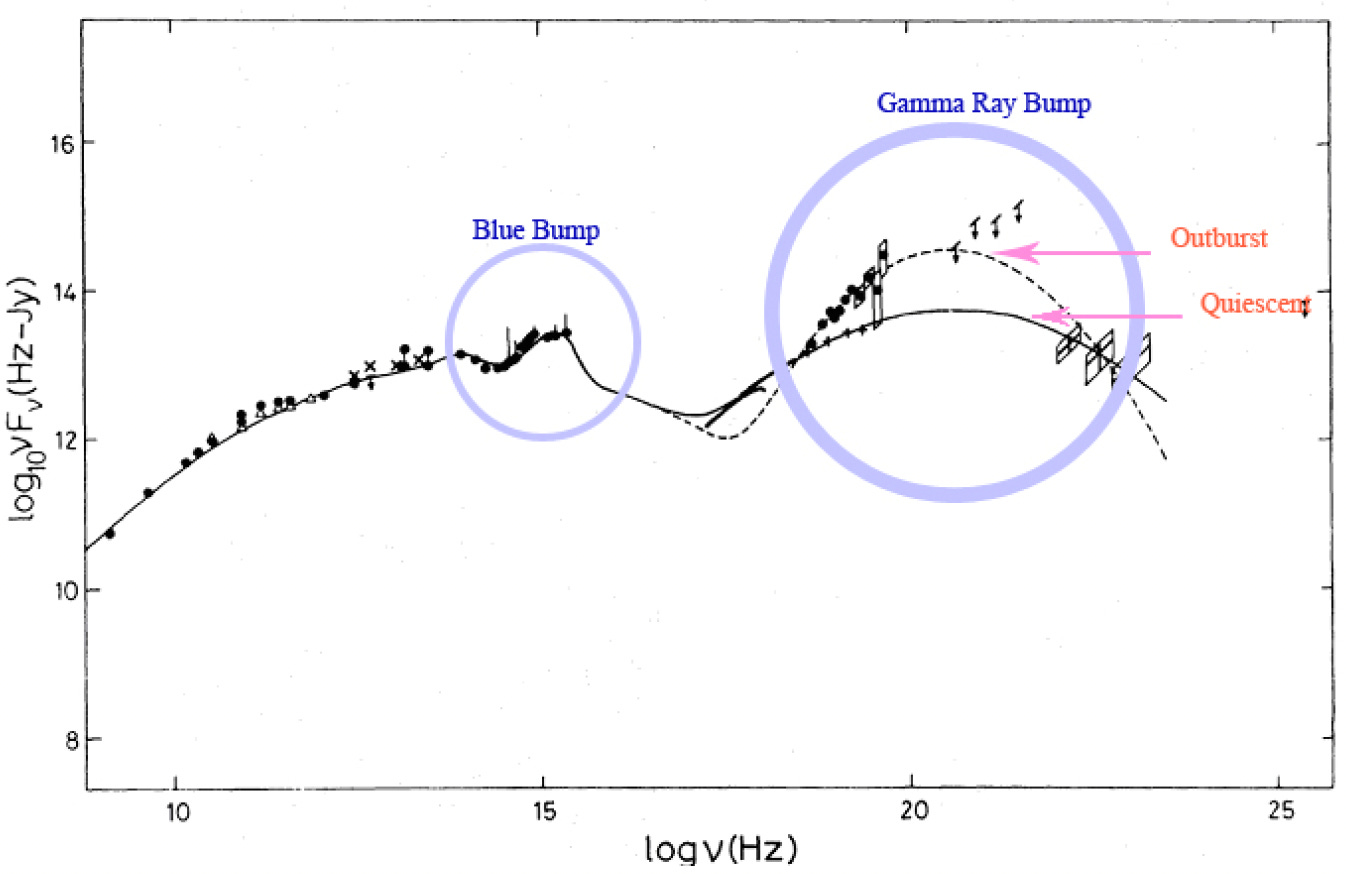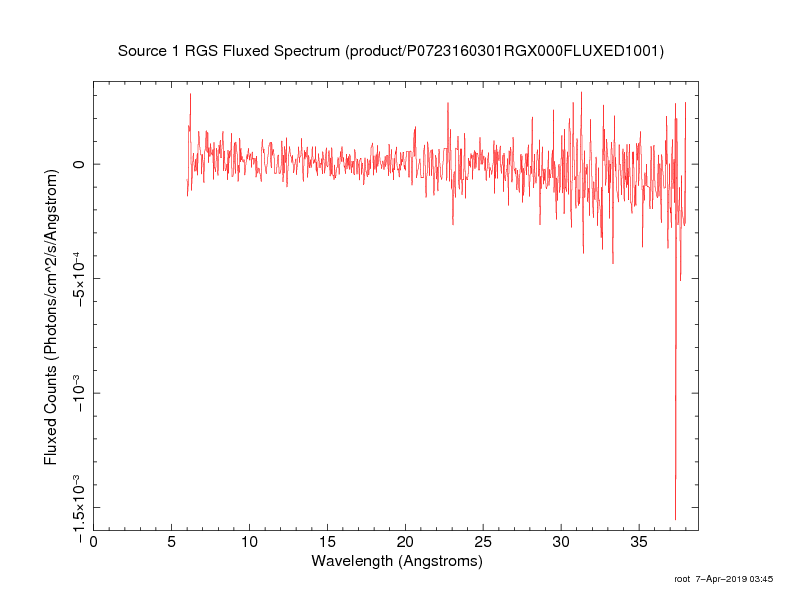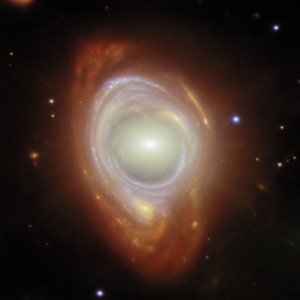There are more things in heaven and earth, Horatio, than are dreamt of in your philosophy (Shakespeare’s Hamlet)
This article was originally published in Substack as “A Silent Monster lurks at the Heart of a Cosmic Lens: X-ray Evidence for a Supermassive Black Hole in the Lensing Elliptical Galaxy”
We, bound by a common origin, composed of elements forged in the nuclear cauldrons of long-dead stars, look up at the stars and, in humility, connect with each other
This is the companion piece to “Married by Einstein”.

The galaxy cluster SMACSJ0028_2-7537 containing the Einstein-ring galaxy pair to the right (east) of the frame. Image produced by the author using JWST data. JWST and Hubble data are publicly available and free to download.
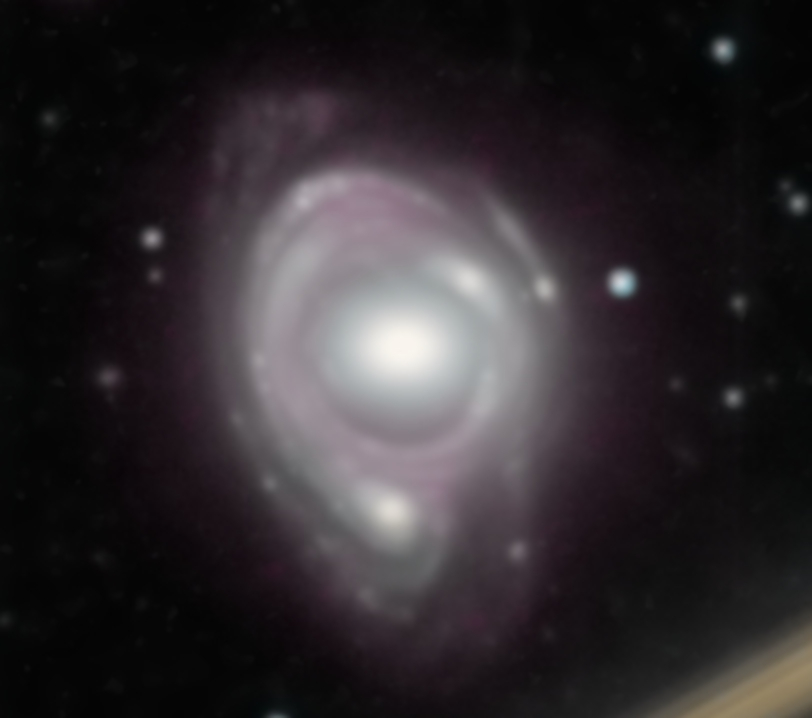
The Einstein-ring galaxy pair, PSZ2G304.84-41.40, image and story first published by the ESA on March 27, is featured here, reproduced here by the author using publicly available JWST and Hubble image data. See the “Featured Image” for the ESA image.
Note: above is a composite image produced by the author from JWST and archival Hubble data. The image data is public access, downloaded from the MAST public archive. The JWST components consist of Near IR data at 1.5 microns (1,500 nm and represented as “green”) and 3.22 microns (3,220 nm and represented as “red”). The Hubble optical data is centered at 606 nanometers (0.606 microns wavelength and represented as “blue”). PSZ2 G304.84-41.40 consists of two galaxies, a foreground “lensing” galaxy with a redshift of 0.41 and a background spiral galaxy with a redshift of 1.02. These details were discussed in “Married by Einstein”. All image processing was by the author with PixInsight and GIMP on MacOS. The image is oriented the same as the image produced by the ESA: north is “up”, east is to the right. Please see our comparison and description below regarding how this image was produced.
No Dark Matter Necessary
Nowhere in this discussion is there any mention of “Dark Matter”. All the imagery and conclusions are perfectly consistent with astrophysical first principles and General Relativity, without resorting to “Dark Matter”.
This pair of galaxies is collectively referred to as PSZ2 G304.84-41.40. For the sake of readability, we will refer to the foreground lensing galaxy as PSZ2-1 and the background spiral, the “lensed” galaxy, as PSZ2-2.
Brand New Discovery
This is a brand new discovery, unrelated to the featured image and story published by the ESA and featured on their Image of the Month portal. While researching “Married by Einstein” and combing through archival data, I found X-Ray data from the XMM Newton orbiting X-ray observatory of the larger galaxy cluster SMACSJ0028.2-7537. This cluster contains PSZ2 G304.84-41.40.
As it turns out, this discovery was the real story. The data shows that PSZ2-1 contains an Active Galactic Nucleus, most likely with a massive central black hole. This black hole may be producing a relativistic jet similar to that produced by the black hole at the center of the elliptical galaxy Messier 87, one of the largest and most massive galaxies in the local universe.
At 54 million light years, Messier 87 is relatively close by almost 2 orders of magnitude – 100x, compared to PSZ2-1. These relativistic jets emit in the radio, optical, and X-ray regimes and are blue in color. This color results from synchrotron radiation, produced when electrons, moving at near light speed along magnetic field lines, emit light. As such, this light would be invisible to JWST as an infrared telescope. At 3.3 billion light years, any relativistic jet would be unresolvable by HST. It would be however, detectable by an X-ray telescope and thus, our story continues below. In terms of mass, size and type, Messier 87 may not be dissimilar to PSZ2-1. Keep reading to learn more.

The giant elliptical galaxy Messier-87 exhibiting its relativistic jet. Image: Hubble Space Telescope, NASA, GSFC, ESA.
Scale and Resolution
The lensing galaxy, PSZ2-1, as featured at the top of the page, can be seen amid the center of the SMACSJ0028.2-7537 cluster of galaxies towards the upper right in the image below. The full width of PSZ2 G304.84-41.40, amid the dozens of other galaxies in the frame, is 6.6 arc-seconds in width or 273x smaller on the sky than either the sun or moon.
This physical width of PSZ2-2, the lensed galaxy, at 7.9 billion light years, the distance represented by its redshift of 1.02, is approximately 29 kiloparsecs (kpc) or 95,000 light-years, comparable in size to our own Milky Way galaxy.

Amidst the galaxy cluster SMACSJ0028.2-7537 is PSZ2 G304.84-41.40, located on the right side of the frame, about 1/3 of the distance below the top edge, just above the intruding light “spike” from JWST’s optical system. The preponderance of objects in this image are elliptical galaxies with a z (redshift) < 1. The elliptical lensing galaxy, as the foreground object of PSZ2 G304.84-41.40, is featured in the close-up at the top of the page. Color image processing by the author using JWST and Hubble data. North is up, east to the right.
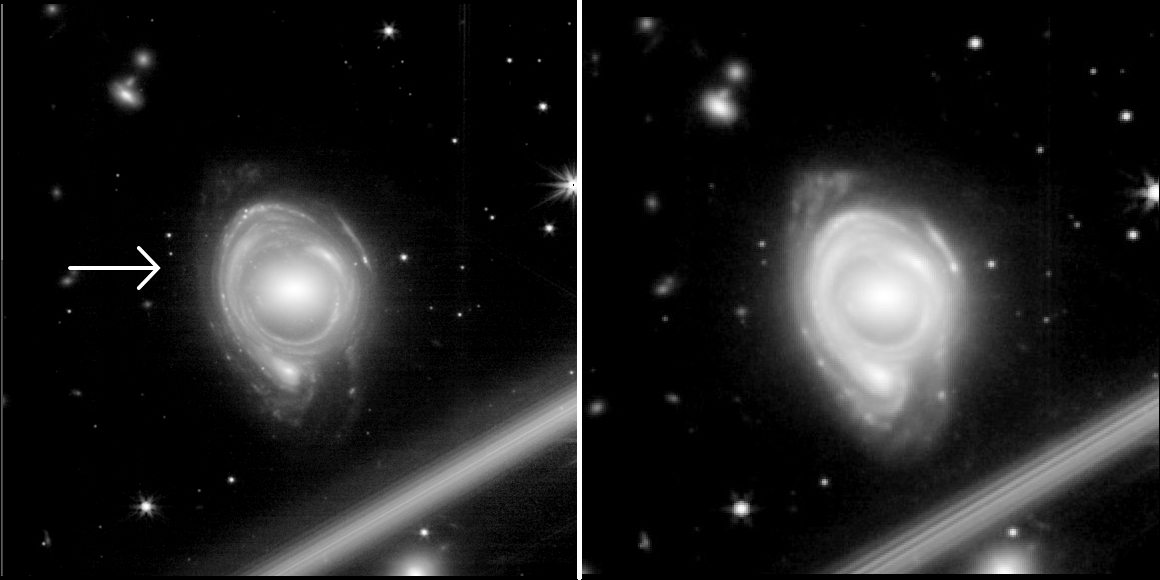
Close-up of PSZ2 G304.84-41.40 at 1.5 microns (1,500 nm, left) and 3.22 microns, (3,220 nm, right), imaged with the JWST and processed by the author with PixInsight and GIMP. Note how the images change from the left frame to the right and the decidedly degraded resolution of the right-hand frame at 3.22 microns. Since resolution is dependent on aperture and inversely dependent on wavelength, the details sharp and clear in the left-hand frame at 1.5 microns, appear much less so in the right-hand frame. Please refer to the text below for a more detailed description.
With JWST’s performance exceeding all exceptions, it may be overlooked that it is an Infrared telescope with limited capabilities in the visible spectrum above 600 nm (red, 0.6 microns).
We should point out that the Hubble Space Telescope’s optical resolving power at short visible wavelengths (blue) is comparable to JWST’s at 600 nm (visible red – near-Ir). This enables the two orbiting platforms to work in tandem, enabling studies and imagery, such as this, to be conducted.
The dependency of resolving power on wavelength -as well as physical aperture (diameter)- is clearly seen in the comparative infrared images above. The 1.5 micron (1,500 nm) image on the left is clear and sharp while the 3.22 micron (3,220 nm) image on the right is “soft”. What is revealed in the right-hand image, however, is the infrared emission of the gas and dust of PSZ2-2’s spiral arms, heated by the hot, young stars embedded within.
Young Stars
It is instructive to point out that many of those new stars, burning hot and bright back then during their youthful brilliance, may now have aged out, have expanded to become red giants, ended their lives in spectacular fashion as supernovae or have gone quietly into that good night as planetary nebulae energized by a hot, central white dwarf star. We see this galaxy as it was when the universe was much younger (see below for exactly how much). This background galaxy, a galaxy perhaps much like our Milky Way, now looks nothing like it did back then, when that light first left it, the light we now see billions of years later.
It took 3.8 billion years for life to emerge here, grow and reach the pinnacle its at today. This is much less time than it took for the light from PSZ2-2 to arrive here. How many planetary systems, races and civilizations have formed there, lived, matured and died in that time? Perhaps they met their end as their stars aged off the main sequence, expanding to become red giants, much like our sun will do in a few billion years hence (https://astronomyforchange.org/some-thoughts-about-summer-arcturus-and-the-future). We will never know who they were. Their history is lost to the universe forever, much like our history will be lost to the universe when our sun eventually ages off the main sequence – if we ever make it that far.
JWST Performance
So, how could we improve the image of the longer-wave Infra-Red images?
We would have to increase the physical aperture (size) of the telescope, something that cannot be done with JWST. We thus accept this tradeoff: optical resolution for new insights into the physical processes and dynamics with increased Infrared imaging capability in particular IR wavebands.
And this is the reason our image of PSZ2 G304.84-41.40 at the top of the page is distinctly different than the featured image below, the image published by the ESA. Since any composite image will only be as good as it’s worst contributing image, the 3.22 micron (3,220 nm) image determines the final quality of the overall composite. See the comparative image above: the 3.22 micron image is to the right and one can immediately see how “soft” it is compared to the 1.5 micron image on the left.
Infrared Images are False Color images
“Color” in the visible spectrum is a subjective property of any image and is assigned by the brain according to wavelength. From shorter to longer wavelengths, blue-violet is at the short-wavelength end of the spectrum at about 400 nanometers while red is at the long-wavelength end at about 700 nanometers (nm). As such, there is no “color” for Infrared or Ultraviolet (or any other regime in the electromagnetic spectrum outside of the visible). Composite Infrared or Ultraviolet images will have their respective components’ “colors” assigned according to wavelength: longer wavelengths will be assigned a warmer or more red color while shorter wavelengths will be assigned a cooler or more blue color.
The Einstein Factor and Einstein Rings
One might wonder why, at 1.8x the distance to PSZ2-1, the lensing galaxy, the background spiral galaxy appears so large. According to the author’s calculations and the application of General Relativity, Einstein lensing has magnified the background galaxy by ~3.3x. We determine its intrinsic (original) size to be 29 ± 5 kpc (95,000 light years) → it’s apparent size would be 3.3x smaller at scale if it were not directly “behind” the foreground elliptical galaxy. PSZ2-2, the background galaxy is thus comparable in size to our Milky Way galaxy at ~30 Kpc (100,000 Ly).
The background spiral galaxy is already as large [and presumably as massive] as the Milky Way, a conclusion consistent with theories of early massive disk formation. To put this into context and quoting from our first piece:
The age of the universe when the light we see first left this galaxy was 5.823 billion years (the universe’s current age is ~13.7 billion years). The light travel time was 7.898 billion years. In other words, it’s ~7.9 billion light years distant. We’re seeing it as it was 7.9 billion years ago, or 3.3 billion years before the sun or solar system formed!
Einstein Rings
An Einstein ring forms when light from a more distant source, such as a galaxy or star, passes by a massive foreground object while en route to an observer. The image thus formed, as the light “follows the curvature of the local space” in the vicinity of the foreground “lensing” object, is distorted. This distorted image often takes the form of a ring surrounding the foreground object, perhaps multiple images surrounding the foreground object, magnifies the background image or a combination of all the above. Einstein rings are clearly seen as arcs in the images above, most notably as bright bluish arcs in the image at the top of the page and in the featured image, below.
The Einstein Radius and the Mass of PSZ2-1, the “Lensing” Galaxy
The Einstein radius is the radius of an Einstein ring. It is the characteristic angle for gravitational lensing in general and varies as the square root of the lensing object’s mass → the greater the mass, the greater the Einstein Radius which makes conceptual sense → the greater the mass of the lensing object, the greater the distortion of space. Distances between images [in gravitational lensing] are approximately equal to an Einstein radius.
In the particular case of this study, the Einstein radius of PSZ2 G304.84-41.40 is approximately equal to the angular distance between the nuclear bulge of PSZ2-1, the center of the image at the top of the page, and the blue arcs (also seen in the “featured image” below). This was computed by the author to be approximately 1.5 arc-seconds or 1200x smaller than the size of the full moon on the sky. This value is consistent with 6.6 arc seconds, the full angular width of PSZ2 G304.84-41.40.
Trillion Solar Mass Galaxy
The application of General Relativity yields a mass of 1.14 Trillion solar masses as the mass of PSZ2-1, a mass that most likely includes that of the central black hole and a mass consistent with, and necessary for, gravitational lensing.
In short, this explains why we observe gravitational lensing in this case.
X-Rays are Redshifted too
As mentioned above, the serendipitous finding of XMM Newton X-ray data corresponding to the larger SMACSJ0028.2-7537 galaxy cluster and what that has led to here is the real story.
Like visible light, X-rays and all electromagnetic radiation (EM Radiation) are subject to the Doppler shift (redshift for objects moving away along our line of site or blue shift, if the object is approaching). The X-rays emitted by PSZ2 G304.84-41.40 have been redshifted from their original rest-frame wavelengths (energies) according to the object’s redshift of 0.41 for PSZ2-1, the lensing elliptical galaxy.
To determine the object’s properties, state and dynamics as they were when they were first produced and emitted, this principle must be applied. Simply put, the X-rays were shorter in wavelength and thus, higher in energy, in their rest frame than when observed now.
What are Active Galactic Nuclei and why would we expect one here?
Why would we expect an Active Galactic Nucleus with a massive central black hole? Because lensing, the warping of the local space, is indicative of a high-mass object. Clearly, that’s the galaxy PSZ2-1 but it could also indicate the presence of a massive central black hole. All the markers are there for that and an AGN.
There is strong evidence that this elliptical galaxy, a bright X-ray source, contains an Active Galactic Nucleus (AGN), a compact region at the center of a galaxy powered by an accreting black hole. It is also a possible QSO (Quasi-Stellar Object) or Quasar.
Active galactic nuclei emit a significant amount of energy across much of the electromagnetic spectrum, typically referred to as a “continuum”. The properties of this emission suggest that this flux is not produced by stars but by other sources.
These non-stellar emissions have been observed in the infrared, optical, ultra-violet and X-ray regimes and constitute an almost full-spectrum continuum. Radio and microwave data are not available and thus, a full-spectrum continuum cannot be confirmed. This continuum is consistent with a pre-quasi-stellar radio source (Quasar).
In the particular case of PSZ2 G304.84-41.40 and, discovered in legacy XMM Newton data, with optical and Infrared counterparts in JWST and Hubble data, is a soft (low energy) X-ray continuum combined with very specific X-ray emissions of heavily ionized Oxygen and Iron superimposed on the X-ray continuum (see spectra below). Even the low-energy X-ray emission (~3.8 nm), is indicative of temperatures above 750,000 kelvin.
The X-ray spectra contain high-confidence markers for an AGN and accreting black hole at the center
Heavily ionized oxygen and iron lines in X-ray spectra are sometimes referred to as “coronal lines” since they are observed in the corona of a black hole’s accretion disk, the hottest region above the disk. These emission lines are present in the X-ray spectrum of PSZ2 G304.84-41.40, superimposed on top of the X-ray continuum, both exhibited below.
Could this be a Quasar?
Quasars are generally associated with an extremely luminous AGN. Initially, I crossed referenced this object with known QSO sources (Quasars) and found no correlation. PSZ2 G304.84-41.40 could be, but isn’t listed. Quasars exhibit broad emission continua beginning in the radio regime through the gamma ray as illustrated below. We lack radio or gamma ray emission data and this could explain why this object is not a QSO and is thus, not listed.
These thermal emissions result from hot gas, spiraling inwards towards the Event Horizon of a central black hole. As the gas gets closer and closer to the Event Horizon, it continues to heat up as the enormous gravitational gradient gets tighter and tighter the closer we get to the black hole’s event horizon, the point of no return. This increasing friction of the gas, as it spirals ever closer to the Event Horizon, causes it to heat up more and more, finally into the million degree range.
Thermal sources in this temperature range produce X-rays.
This is most likely the case with PSZ2 G304.84-41.40.
Illustrating a continuum across much of the Electromagnetic Spectrum above, is the log-log plot of flux vs. frequency for the famous Quasar 3C-273. An X-ray continuum is observed from the right edge of the “Blue Bump” to the left edge of the “Gamma Ray bump”, spanning 3 orders of magnitude from 3×1016 hz to 3×1019 hz (hz is an abbreviation for “cycles per second”).
Elliptical Galaxies Lack Much Star Forming Gas and Dust
PSZ2-1 is an elliptical galaxy. Compared to spiral galaxies, elliptical galaxies have much less gas and dust, the raw materials of star formation. The X-ray continuum of PSZ2-1 (below) compares favorably with the illustration of the famous quasar 3C-273, above. While PSZ2-1 itself may not have abundant gas and dust, the central black hole can draw material from other sources like disrupted stars or even the intergalactic medium.
A Full Spectrum Continuum Exists for PSZ2-1
An almost full spectrum continuum begins in the Infrared for this elliptical galaxy and continues unbroken through the low-energy X-ray regime. We present the low-energy X-ray continuum above. We obtained GALEX Ultraviolet data with JWST and Hubble providing the Infrared and optical data respectively. This almost full-EM continuum, combined with specific x-ray lines (below) represent high-confidence markers for a weak Active Galactic Nucleus (AGN) and accreting black hole.
Obtained by the XMM Newton orbiting x-ray observatory in 2013, the following X-ray spectra exhibit high-confidence markers for a weak AGN and and accreting black hole at the center of PSZ2-1.
The low-energy X-ray spectra of PSZ2-1, the lensing elliptical galaxy, includes deep ionization lines of Oxygen and Iron, indicated in red (above) and detailed below.
| Observed Wavelength (Å) | Identification | Rest Energy (keV) | Origin |
| 31.2 ± 0.1 | O VII (forbidden) | 0.561 | AGN narrow-line region |
| 32.7 ± 0.1 | Fe XVII (3s→2p) | ~0.534 | AGN corona or hot gas |
| 37.5 ± 0.1 | Fe XVII (3d→2p) | ~0.466 | AGN corona or hot gas |
Just as the solar corona describes the tenuous, hot, outer layer of the sun’s atmosphere, the term Corona in this context is used to describe the hot, outer layer of an AGN’s accretion disk as the gas spirals inward towards the powerful gravitating source at the center, the massive black hole.
Coronal spectral lines are bright emission features produced by super heated gas as it spirals inwards toward the supermassive black hole at the center. These lines are produced by atoms that have been heavily stripped of electrons (ionized) by super-heated gas and intense radiation, requiring energies greater than 100 times that required to ionize hydrogen.
Since only the extreme environment around an active galactic nucleus (AGN) can power such processes, these lines serve as clear fingerprints and high-confidence markers for hidden black hole activity at the center of galaxies.
Featured image
The image of PSZ2 G304.84-41.40, released by the European Space Agency (ESA) and published on March 27, is our featured image for this article. The image is an infrared and optical (visual) composite using JWST and Hubble data respectively. As is the case with all composite images containing image data outside the visual regime, the false color is assigned according to increasing wavelength: the longer wavelengths, the redder the color. The blue Einstein rings and central core of the elliptical galaxy at the center were provided by the Hubble Space Telescope.
The origin of those “rings” are luminous O, B and A class stars in the gas and dust rich spiral arms of the background galaxy with the preponderance of the light in the UV-A, UV-B wavelength regimes. That light has been redshifted from the Ultraviolet to the long-wave optical (yellow – red).
Coming soon, look for our full video of this discovery.
A quick, interactive web-based version of Stellarium is available here Tonight's Sky. When you launch the application, it defaults to north-facing and your location (on mobile and desktop).
Astronomy For Change: https://astronomyforchange.org
Did you enjoy this article or like what we do? Why not leave a tip or buy us a Coffee?
Follow Us On Twitter: https://twitter.com/astronomychange
Why not support us on Patreon: https://www.patreon.com/astronomyforchange
Imagination is more important than knowledge
![]()
An index of all articles can be found here.
If you enjoyed this article, please consider supporting us with a modest donation
or through a subscription on our Patreon Page
Membership at Astronomy for Change is Free!

